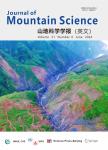Effects of Topography and Land use on Woody Plant Species Composition and Beta Diversity in an Arid Trans-Himalayan Landscape, Nepal
Effects of Topography and Land use on Woody Plant Species Composition and Beta Diversity in an Arid Trans-Himalayan Landscape, Nepal作者机构:Natural Resources Ecology and Management Oklahoma State UniversityStillwater OK 74078 USA Department of Geography University of BergenPost Box 7800 N-5020 Bergen Norway
出 版 物:《Journal of Mountain Science》 (山地科学学报(英文))
年 卷 期:2014年第11卷第5期
页 面:1112-1122页
核心收录:
基 金:Annapurna Conservation Area Project (ACAP) Norwegian State Educational Loan Fund (Lnekassen) Faculty of Mathematics and Natural Sciences,University of Bergen for financing funded by Norwegian Research Council(project no.148910/730) supported by The Norwegian Council for Higher Education Programme for Development Research and Education(NUFU Project ID:PRO 04/2002)
主 题:Correspondence analysis Diversity Environmental gradients Himalaya Land use Topographic aspect Woody vegetation
摘 要:Distribution patterns of plant species are believed to be impacted by small-scale habitat heterogeneity. However, there have been few comparative studies examining how woody vegetation composition and diversity varies with aspects of different orientations in the Trans-Himalayan region at a local scale. Here, we examined the effects of incoming solar radiation on variation in woody species composition and compared the diversity between the northeast- and southwest-facing slopes in a Trans-Himalayan valley of Nepal. We also examined the implicit interactions between slope orientation and land use in determining the compositional variations between the slopes. We selected two pairs of northeast- and southwest-facing slopes where the first pair has a similar land use and differs in exposure only(Pisang site) while the other pair has clear differences in land use in addition to slope exposure(Braka site). In each site, we sampled 72 plots(36 on each slope) in which the presence and absence of woody species, environmental variables, and disturbance were recorded. Correspondence Analysis(CA) results suggested that the woody species composition significantly varied between northeast- and southwest-facing slopes at both sites, and was significantly correlated with measured environmental variables such as radiation index, altitude, and canopy openness. In the Braka site,mean alpha diversity was significantly higher on southwest-facing slopes. In contrast, beta diversity and gamma diversity were greater on northeast-facing slopes at both sites. Our results suggest that topographic variables(e.g., radiation index) affect species composition between the slopes, likely due to their influence on small scale abiotic environmental variables. However, the effects of land use, such as livestock browsing/grazing may interact with the effects of slope exposure, effectively reducing differences in species composition within slopes but enhancing the differences in beta diversity between



